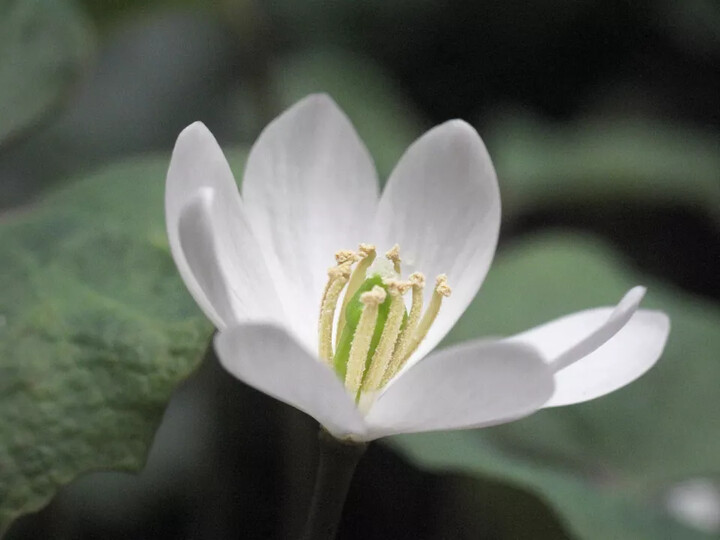Twinleaf (Jeffersonia diphylla) is of the Barberry (Berberidaceae) family, which has many perennial herbs and shrubs that often have flowers borne singly or in clusters atop spiny stems. The only other species of Twinleaf is J. dubia, native to Japan.
When American botanist Benjamin Smith Barton found Twinleaf growing in the Pennsylvania garden of William Bartram, he renamed the plant Jeffersonia diphylla in honor of Thomas Jefferson who was also a fellow botanist.
Native to Eastern North America, J. diphylla is a woodland wildflower that grows beneath the canopy of trees from Ontario southward, from Wisconsin to New York, to North Carolina, Georgia and northern Alabama.
Twinleaf is a clump-forming plant, which grows about eight inches tall while flowering and goes on to grow up to three feet tall when the fruit ripens.
The fragile flowers are white and they bloom in March or April and only last a few days. On each leafless stalk, a single cup-shaped flower blooms as three- to five-inch leaves emerge. The common name twinleaf is inspired by the identical lobes of the leaf, shaped like angel wings at the top of the stems.
Forming like a star, each flower is about one inch in diameter and has about eight petals arranged in two rows. Flowers resemble the aesthetic of the completely unrelated bloodroot.
One-inch round capsular pear-shaped fruit pods are borne in May to produce brown seeds. Fruit pods are brown-copper or gold-yellow.
Twinleaf makes a good companion plant to many other woodland species including hepatica, woodland phlox, early meadow-rue and false rue anemone.
Botanical Name:
Jeffersonia diphylla
Common Names:
Twinleaf
Plant Type:
Herbaceous perennial, native wildflower
Mature Size:
Eight inches to three feet tall, one foot to sixteen inches wide
Sun Exposure:
Part shade
Soil Type:
Moist, humusy, well-drained, limestone
Soil pH:
Acidic (<6.8)
Bloom Time:
March or April
Flower Color:
White
Hardiness Zones:
5 - 7, USA
Native Area:
Eastern North America
Twinleaf Care
To welcome this woodland wonder to your shade garden, plant in a moist and cool site among native plants. Twinleaf also works well in shaded areas of rock gardens. Mass plantings quickly bring about an efficient groundcover.
The flower petals are so fragile that they can drop at the first gust of wind or first rainfall of early spring. Establish young plants together and free from weeds.
Light
Twinleaf prefers part shade (direct sunlight that lasts only two to six hours of the day) and will tolerate full/deep shade (less than two hours to no direct sunlight).
Find a spot beneath canopies of large deciduous trees for best results, as these conditions will offer part sun in early spring and lush shade in the heat of summer.
Soil
Plant in moist, humusy, well-drained loam. Twinleaf is most at home in the limestone soils of organically rich damp woods.
Some gardeners have had success growing this perennial in a mixture of sand and peat. Others report that twinleaf will grow in alkaline soil, though acidic soil (<6.8) is highly recommended.
Water
Cover with mulch in summer to maintain cool roots, and allow the soil to dry out.
Is Twinleaf Toxic?
Also known as Rheumatism Root, some Native American tribes used Twinleaf externally to help treat skin problems like ulcers and inflammation.
It was even administered as a tea for ailments including stomach cramps, stress, and urinary infection.
When the root is consumed in large doses it acts as an emetic and can induce vomiting. In smaller doses, it is known as an expectorant and can help to expel phlegm. Containing berberine, the root may be able to combat tumor growth.
Even so, there haven't been many contemporary studies done on Twinleaf. For modern-day use, practice extra caution.
Propagating Twinleaf
Divide these herbaceous perennial plants at the end of the growing season. They can also be easily propagated by seed.
Collect seeds three to four weeks after bloom. Sow as soon as seeds are ripened so they do not dry out. Seedlings take four to five years to develop into flowering plants.
Common Pests/Diseases
Fortunately, there are no serious insect or disease problems. While the preferred moist conditions may make Twinleaf susceptible to slugs or snails, overall this is a very low-maintenance and versatile plant to bring to your shade garden.
You Might Like ...